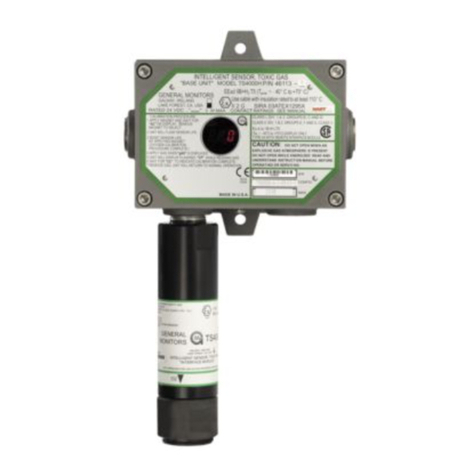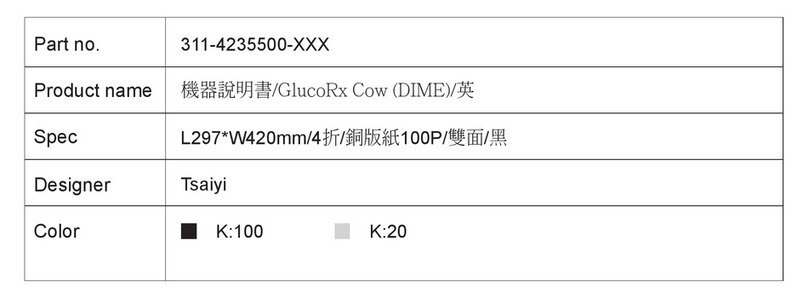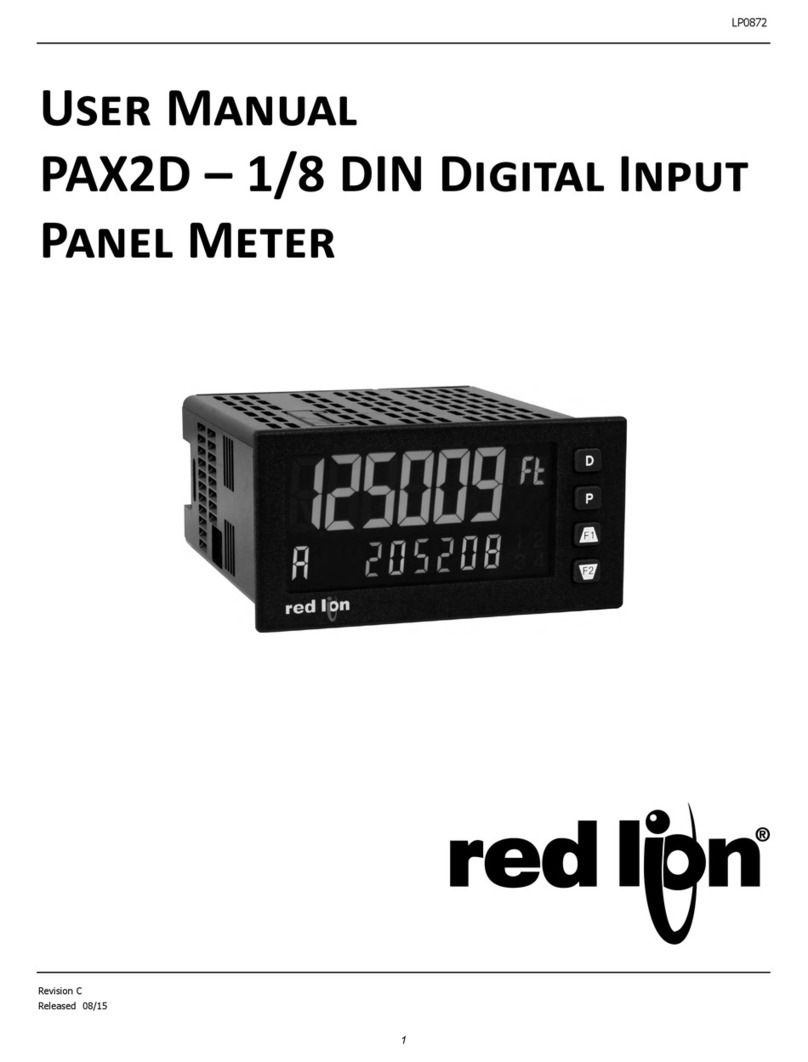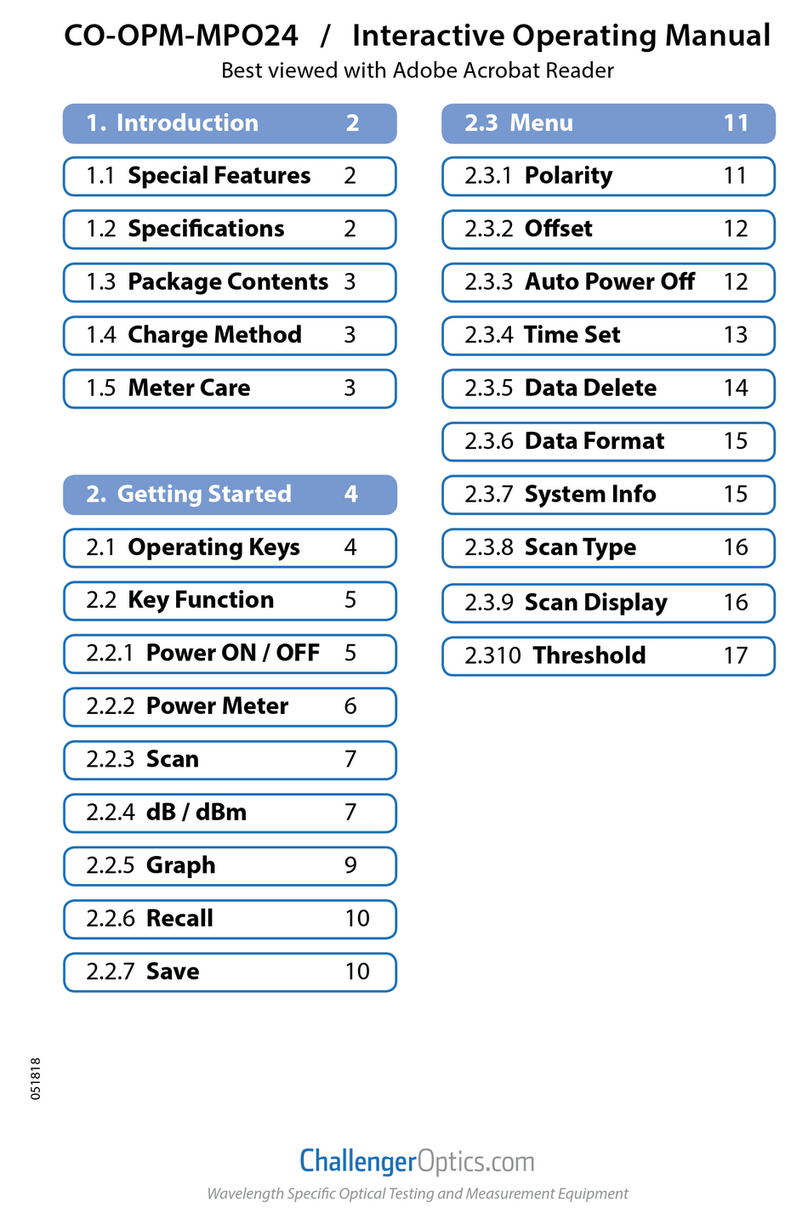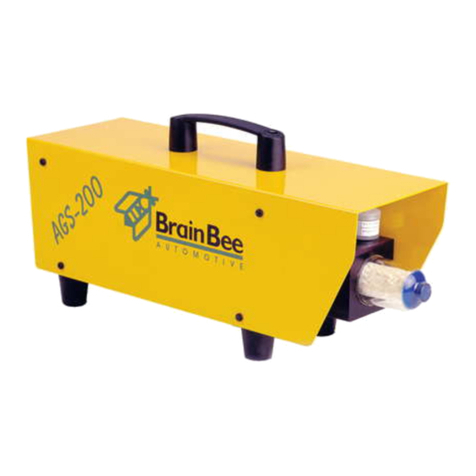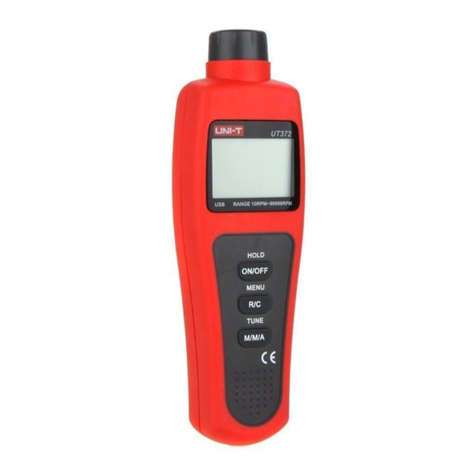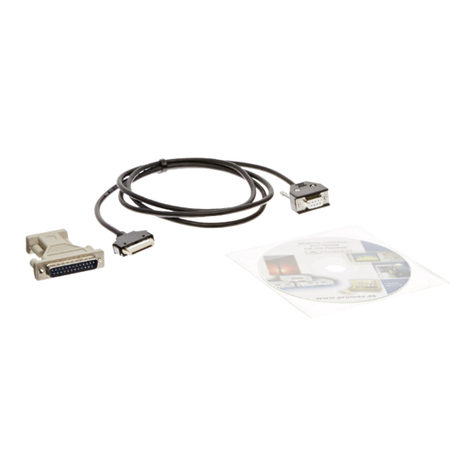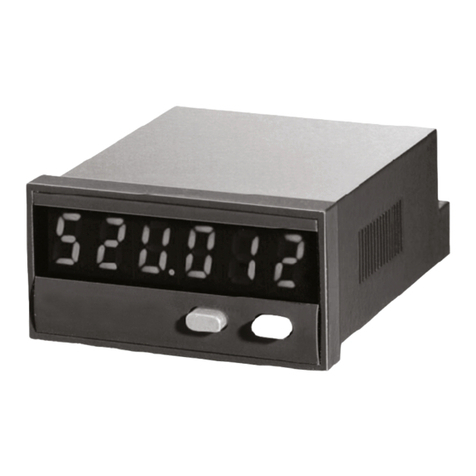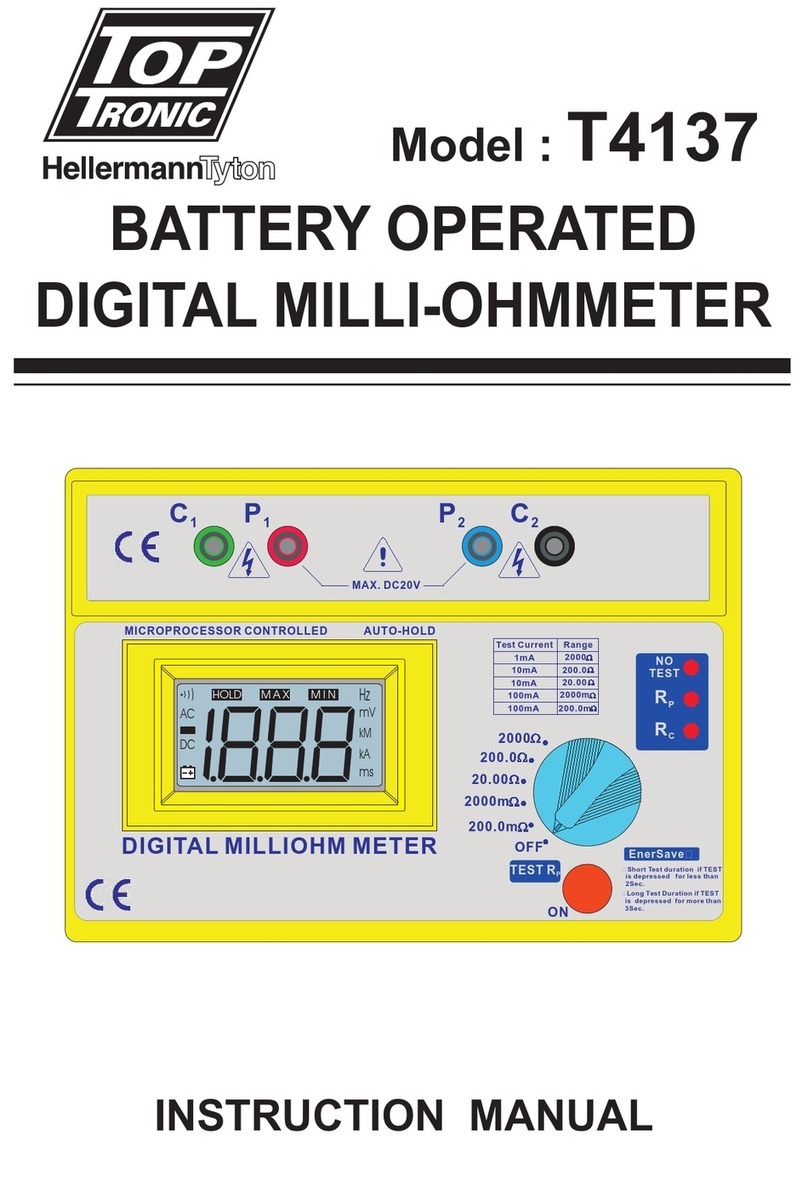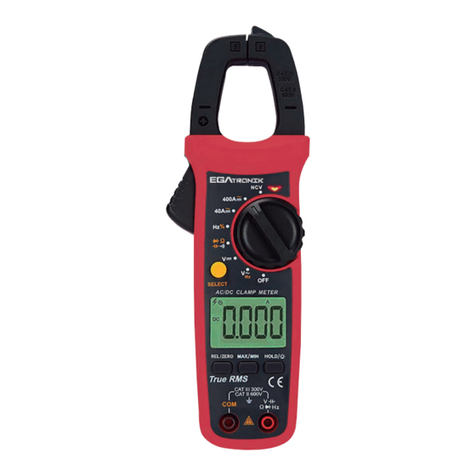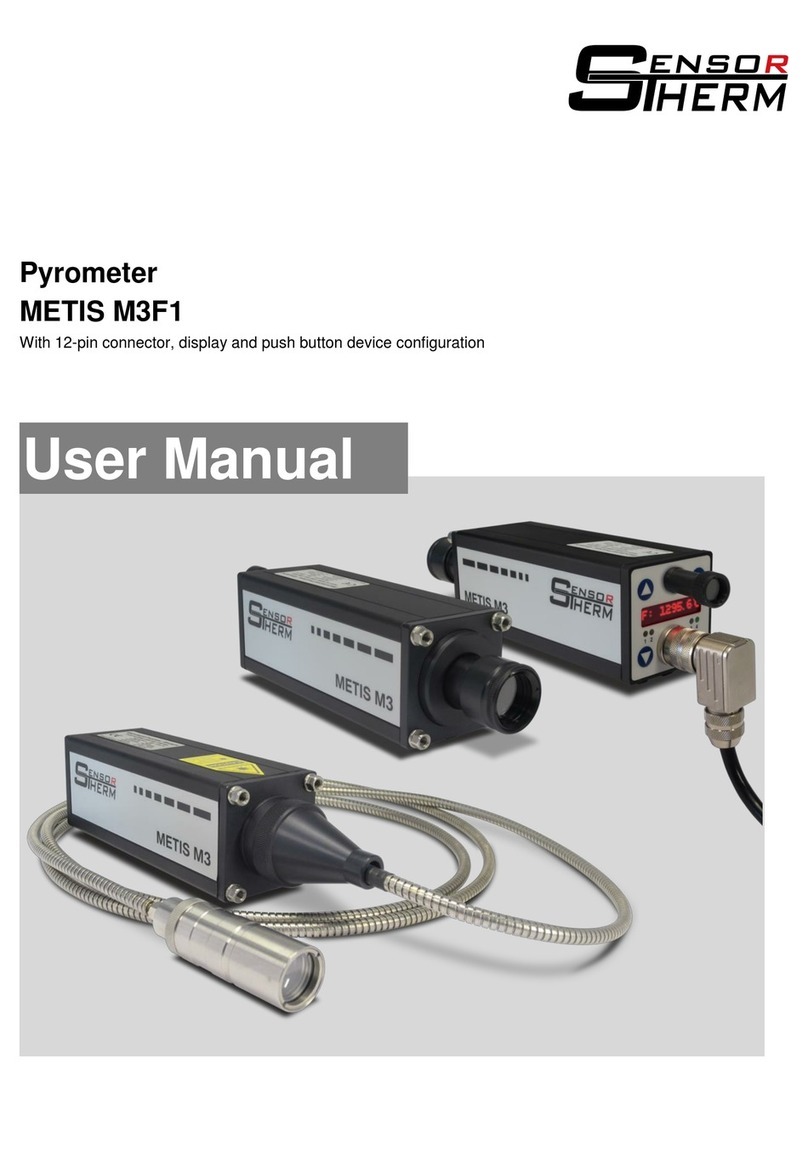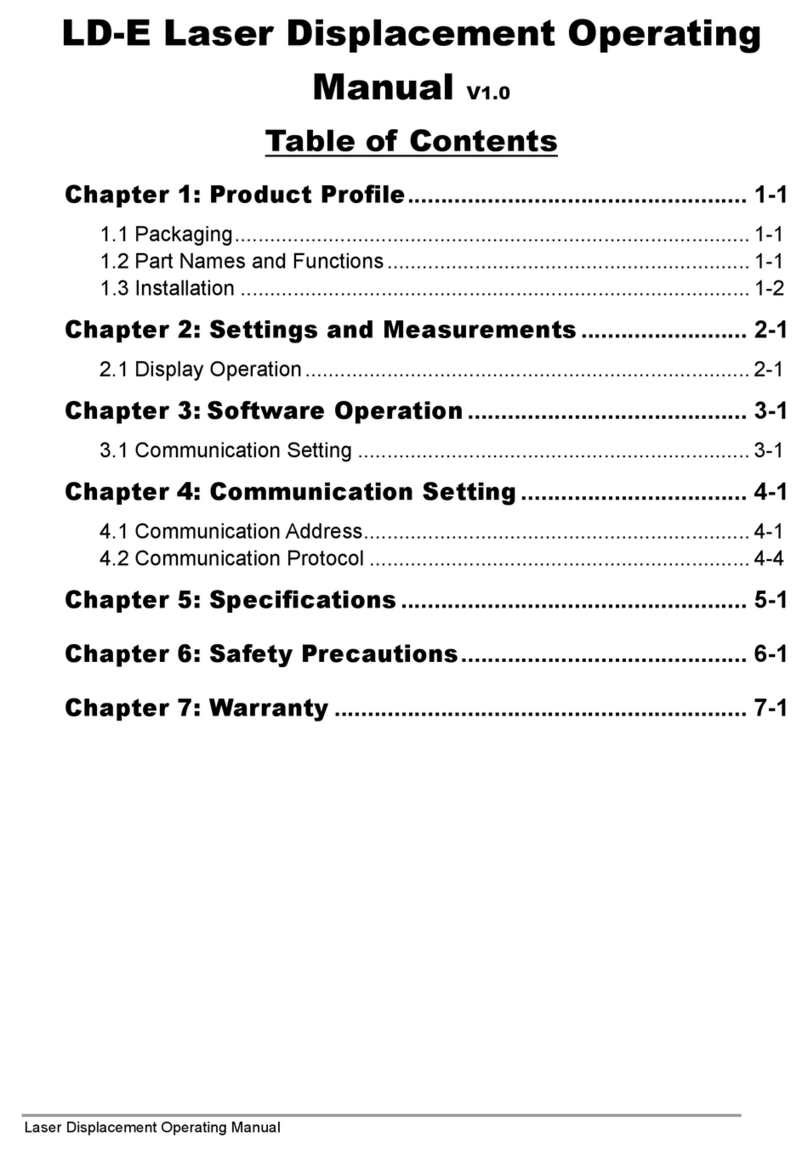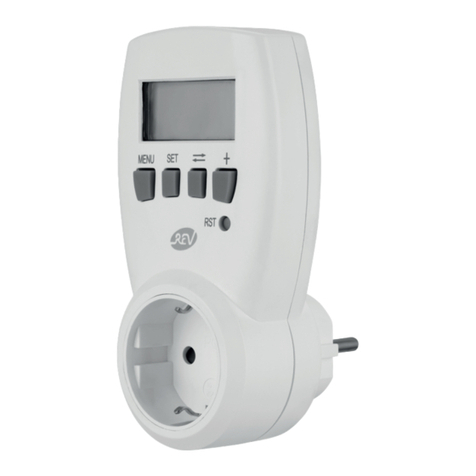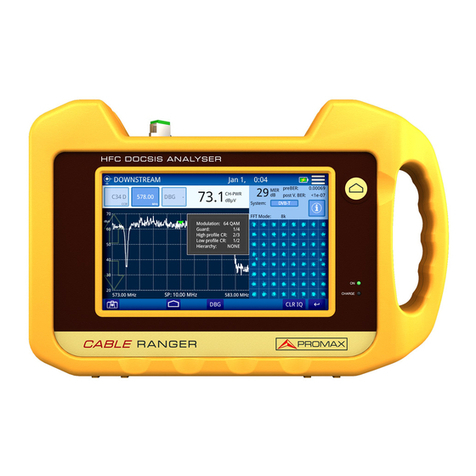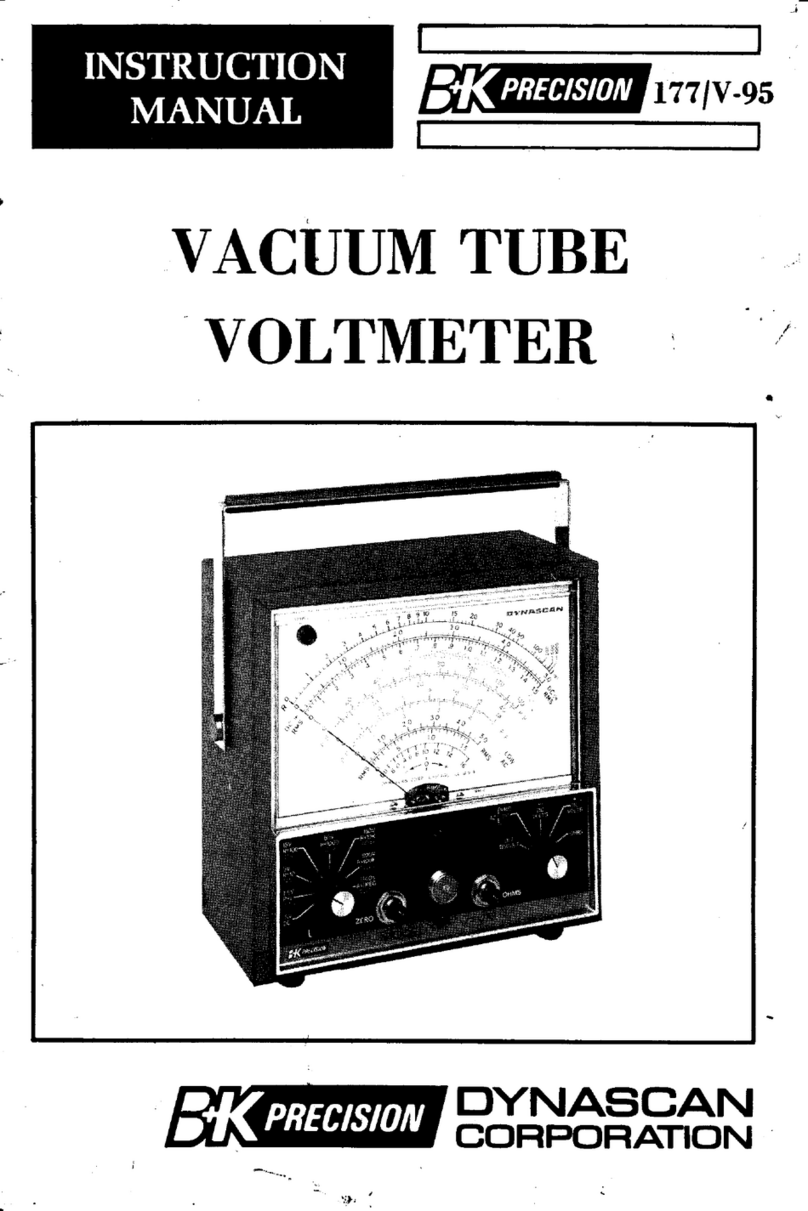General Monitors S800 User manual

Model S800
Machine Mounted Methane
Monitoring System
The information and technical data disclosed in
this document may be used and disseminated
only for the purposes and to the extent
specifically authorized in writing by General
Monitors.
Instruction Manual 1006
General Monitors reserves the right to change
published specifications and designs without
prior notice.
MANS800
Part No. MANS800
Revision D/12-07

Model S800
i
Table of Contents
Figures…………………………………………………………………………………………...iii
Warranty Statement…………………………………………………………………………….1
Warnings…………………………………………………………………………………………1
System Integrity Verification………………………………………………………………… 2
1.0 Introduction………………………………………………………………………………… 3
1.1 Notice……………………………………………………………………………………………….3
1.2 General……………………………………………………………………………………………..3
1.3 Features and Benefits…………………………………………………………………………….3
2.0 System Specifications…………………………………………………………………….4
2.1 Notice……………………………………………………………………………………………….4
2.2 System Specifications…………………………………………………………………………….4
2.3 Mechanical Specifications………………………………………………………………………..4
2.4 Electrical Specifications…………………………………………………………………………..5
2.5 Environmental Specifications…………………………………………………………………….5
2.6 System Description………………………………………………………………………………..6
3.0 Installation………………………………………………………………………………….. 7
3.1 Notice……………………………………………………………………………………………….7
3.2 Upon Receipt of Equipment……………………………………………………………………...7
3.3 Power Supply Installation………………………………………………………………………...7
3.4 S800 Installation…………………………………………………………………………………..7
3.5 S800 Terminal Connections……………………………………………………………………...8
3.6 Installation Check-Out…………………………………………………………………………….8
3.7 Sensor Locations………………………………………………………………………………….9
3.8 Sensor Poisons…………………………………………………………………………………..11
4.0 Operation………………………………………………………………………………... 12
4.1 Notice……………………………………………………………………………………………...12
4.2 General Maintenance……………………………………………………………………………12
4.3 Electrical Inputs/Outputs………………………………………………………………………...12
4.4 Alarm Conditions…………………………………………………………………………………12
4.5 Latch/Non-Latch Alarm………………………………………………………………………….13
4.6 LED Test Feature……………………………………………………………………………... 13
4.7 Ramp Test Feature………………………………………………………………………………13
4.8 Fault Diagnostics…………………………………………………………………………………13
5.0 User Interfaces…………………………………………………………………………….15
5.1 Notice……………………………………………………………………………………………...15

Model S800
ii
5.2 Types of Interfaces………………………………………………………………………………15
5.3 Auto-Calibration Mode………………………………………………………………………... 15
6.0 Sensor Assembly/Accessories………………………………………………………...18
6.1 Notice……………………………………………………………………………………………...18
6.2 Sensor Housing…………………………………………………………………………………..18
6.3 Splash Guard……………………………………………………………………………………..18
6.4 Dust Guard Assembly…………………………………………………………………………...19
6.5 Calibration Equipment…………………………………………………………………………...20
7.0 Technical Information……………………………………………………………………21
7.1 Spare Parts……………………………………………………………………………………….21
7.2 S800 Tool List…………………………………………………………………………………….22
7.3 Electronic Module………………………………………………………………………………..23
7.4 Module Base Assembly…………………………………………………………………………24
7.5 Power Supply Assembly………………………………………………………………………...25
7.6 Detector Housing Assembly…………………………………………………………………….26
8.0 MSHA Installation Letter………………………………………………………………...27

Model S800
iii
Figures
Figure 1: Wire Strip Length........................................................................................... 8
Figure 2: Color Coded Wiring Connections ................................................................10
Figure 3: User Interfaces/Displays.............................................................................. 15
Figure 4: Entering Auto-Calibration Sepuence ...........................................................16
Figure 5: “AC” Auto-Calibration Display......................................................................16
Figure 6: “CP” Auto-Calibration Display......................................................................16
Figure 7: “CC” Auto-Calibration Display...................................................................... 17
Figure 8: Sensor Housing Drawing.............................................................................18
Figure 9: Splash Guard, Picture..................................................................................19
Figure 10: Dust Guard .................................................................................................19
Figure 11: Dust Guard Kit............................................................................................ 19
Figure 12: Electronic Module.......................................................................................23
Figure 13: Module Base Assembly...............................................................................24
Figure 14: PowerSupply Assembly............................................................................... 25
Figure 15: Detector Housing Assembly .......................................................................26

Model S800
1
Warranty Statement
United Central Industrial Supply, exclusive Mining distributor for General Monitors,
Warrants the Model S800 to be free from defects in workmanship or material under normal
use and service within one (1) year from the date of shipment. General Monitors will repair or
replace without charge any such defective equipment to be found defective during the
warranty period. Full determination of the nature of, and Responsibility for, defective or
damaged equipment will be made by General Monitors personnel. Defective or damaged
equipment must be shipped prepaid to General Monitors plant or the representative from
which shipment was made. In all cases this warranty is limited to the cost of the equipment
supplied by General Monitors. The customer will assume all liability for the misuse of this
equipment by its employees or other Personnel. All warranties are contingent upon proper
use in the application for which the product was intended and do not cover products which
have been modified or repaired without General Monitors approval or which have been
subjected to neglect, accident, improper installation or application, or on which the original
identification marks have been removed or altered. Except for the express warranty stated
above, General Monitors disclaims all warranties with regard to the products sold, including
all implied warranties of merchantability and fitness and the express warranties stated herein
are in lieu of all obligations or liabilities on the part of General Monitors for damages
including, but not limited to, consequential damages arising out of/or in connection with use
or performance of the product.
Warnings
–Combustible & flammable gases and vapors are very dangerous.
–Extreme caution should be used when combustible & flammable gases and vapors
are present.
–Where applicable, adhere to Mine Safety and Health Administration guidelines for
service and installation.
–Only catalytic bead sensors designed by General Monitors will work with the Model
S800. Any attempt to use a sensor that has not been designed by General
Monitors will void the warranty.
SAFETY WARNING:
Installation and maintenance must be carried out by suitably skilled
and competent personnel only.

Model S800
2
System Integrity Verification
General Monitors’ mission is to benefit society by providing solutions through industry-
leading safety products, services and systems that save lives and protect capital resources
from the dangers of hazardous flames, gases and vapors.
The safety products you have purchased should be handled carefully and installed,
calibrated, and maintained in accordance with the respective product instruction manual.
Remember, these products are for your safety.
To ensure operation at optimum performance, General Monitors recommends that certain
maintenance items are performed.
Commissioning Safety Systems
Before power up, verify wiring, terminal connections and stability of mounting for all integral
safety equipment including, but not limited to:
•Power supplies
•Control modules
•Field detection devices
•Signaling / output devices
•Accessories connected to field and signaling devices
After the initial application of power (and any factory specified warm-up period) to the safety
system, verify that all signal outputs, to and from devices and modules, are within the
manufacturers’ specifications. Initial calibration / calibration checking / testing should be
performed per the manufacturers’ recommendations and instructions.
Proper system operation should be verified by performing a full, functional test of all
component devices of the safety system, ensuring that the proper levels of alarming occur.
Fault/Malfunction circuit operation should be verified.
Periodic Testing/Calibration of Field Devices
Periodic testing/calibrating should be performed per the manufacturers’ recommendations
and instructions. Testing/Calibrating procedures should include, but not be limited to:
•Verify zero reading
•Apply a known concentration of gas, or a simulated test device provided by the
manufacturer
•Verify integrity of all optical surfaces and devices
When testing produces results outside of the manufacturers’ specifications, re-calibration or
repair/replacement of the suspect device(s) should be performed as necessary. Calibration

Model S800
3
intervals should be independently established through a documented procedure, including a
calibration log maintained by plant personnel, or third party testing services.
1.0 Introduction
1.1 Notice
This Chapter provides a brief description of the Model S800 and its’ features & benefits.
More detailed information on the features and benefits listed in section 1.2 will be presented
in later chapters.
The S800 is easy to install and operate; however, this manual should be read in full, and the
information contained herein understood before attempting to install or operate the system.
1.2 General
The General Monitors Model S800 Smart Methane Monitoring System is a single
channel monitoring system designed specifically for the mining industry for installation
on longwalls, continuous miners and other face cutting equipment. It is supplied
through our exclusive mining distributor, United Central Industrial Supply (UCISC).
UCISC should be consulted if service beyond the scope of this manual becomes
necessary.
The Model S800 is based upon General Monitors latest sensing technology and consist
of an S800 Power Supply Module, a remote mounted catalytic bead sensor in its own
explosive-proof housing, and a large LED display (approximately two inches high
available in yellow or red) incorporated into an explosion proof (XP) housing.
The basic system is a single channel unit; however, two channel operation may be
achieved by adding an additional display unit and an additional sensing unit.
1.3 Features and Benefits
Single Point, Auto-Calibration: the unit’s display indicates simple automated
calibration prompts to the operator with no adjustments of “zero” and “span” required.
Microprocessor Based Electronics: Monitors fault conditions and sensor inputs and
provides outputs in the form of display codes and relay contacts.
Power On Self Test (POST): this is a test that is performed by the microprocessor
each time power is applied to the S800.
LED Test: tests the integrity of each LED and each segment of the digital display.
Ramp Test: tests the functionality of the instrument through the microprocessor
ramping up in the signal from the present gas level to full scale and back.
The Model S800 Smart Methane Monitoring System is approved for use by The
Mine Safety and Health Administration (MSHA).

Model S800
4
2.0 System Specifications
2.1 Notice
This Chapter provides detailed specifications for the model S800 Machine Mounted
Methane Monitoring System. The system mechanical, electrical and environmental
specifications present the Model S800 in Technical terms. The unit description is
provided for insertion into other written specifications by architects and engineers.
2.2 System Specifications
Application: combustible & flammable gas and vapor detection.
Sensor Type: General Monitors low temperature, catalytic bead, limited diffusion
sensor.
Measuring Range: 0 to 5% Methane gas by volume or 0 to 100%LEL.
Accuracy: ±3% of full scale for gas concentrations up to and including 50% of full
scale. For gas concentrations greater than 50%, the accuracy of the systems will be
±5% of the full scale gas concentration.
Zero Drift: less than 5% of span per year.
Response Time: Time to 50% of full scale < 10 seconds with 100%LEL concentration
of Methane applied. Time to 90% of full scale < 30 seconds with 100% LEL
Concentration of Methane Applied.
User Protection: The Model S800 is MSHA certified (Cert# 32A-23/MS-0),
Commonwealth of Pennsylvania approved (Cert# BFE 1275-96) and warranted for one
year on parts and labor.
AWG Feet Meters
14 7600 2320
16 4800 1460
2.3 Mechanical Specifications
Power Supply:
Weight: 5 lbs 2 oz (2.3 Kg)
Length: 8 inches (20.3 cm)
Height: 3.5 inches (8.9 cm)
Width: 5 inches (12.7 cm)

Model S800
5
Sensor Housing with Sensor:
Weight: 6 lbs 7 oz (2.9 Kg)
Depth: 8.5 inches (21.6 cm)
Height: 2.2 inches (5.6 cm)
Width: 3.2 inches (8.1 cm)
Electronics with XP Housing:
Weight: 8 lbs 10 oz (3.9 Kg)
Depth: 5.6 inches (14.2 cm)
Height: 4.6 inches (11.7 cm)
Width: 8 inches (20.3 cm)
2.4 Electrical Specifications
Input Power Requirements: To Power Supply-120Vac ±25% @ 150mA.
To Instrument-13 to 17 Vdc (15 Vdc @ 500mA nominal).
Electrical Classifications: the sensor is rated for use in Class I, Division 1, Groups B,
C & D. The model S800 is designed for use in hazardous environments.
Machine Cut-off Relay Output: 10A @ 120Vac SPDT, 5A @ 600Vac SPDT.
Remote Output: 10A @ 12Vdc SPDT, 10A @ 120Vac SPDT.
Cable Parameters: Recommended 3 wire shielded, maximum cable lengths allowable
between module and sensor with one way resistance of 10Ohms per sensor lead
(20 Ohms Loop) @ 4.5Vdc nominal is 7600 feet (2320 Meters) using 14 AWG.
2.5 Environmental Specifications
Operating Temperature Range:
Sensor: -67F to +200F (-55C to +93C)
S800: -40F to +140F (-40C to +60C)
Operating Humidity Range: 0 – 95% relative humidity (non-condensing)
Vibration Specifications: as per Mine Safety and Health Administration (MSHA).
Weather Proof Protection: Conforming to weather proofing per NEMA 4X.
Radio Frequency
Interference Susceptibility: Conforms to levels defined by IEC 801-3 Severity Level 3.

Model S800
6
2.6 System Description
The monitor and sensor shall be MSHA approved and be capable of monitoring 0 to
5% Methane gas by volume or 0 to 100% LEL concentration. The monitor shall have an
interface panel, providing magnetic switches for the following indications: 2-discrete
alarm threshold level indicators, a fault or malfunction indicator, a calibration mode
indicator and a 2-digit display. All alarm parameters and user options shall be
configurable by qualified personnel. A power on self-test (POST) shall automatically be
performed each time the monitor powers up. A functional ramp test and LED test shall
be switch capable without interrupting normal on-line services.
The monitor will generate display codes associated with fault conditions whenever a
fault or malfunction occurs. A magnetic switch shall provide the operator front panel
access to a calibration mode. The monitor, with sensor, shall be capable of calibration
with the following display prompts during the calibration routine:
AC = Calibration routine Activated
CP = Calibration in Progress
CC = Calibration Complete

Model S800
7
3.0 Installation
3.1 Notice
This Chapter outlines what steps to take when the Model S800 is received, the terminal
connections & designations, sensor locations and what to be aware of when applying
power.
3.2 Upon Receipt of Equipment
All equipment shipped by General Monitors is packaged in shock absorbing containers
which Provide considerable protection against physical damage. The contents of the
package should be carefully removed and checked. If any damage has occurred in
shipping, or if there is a discrepancy in the order, notify United Central Industrial Supply
immediately. Please specify the affected part and serial number if applicable. Each
Model S800 is completely checked out at the factory; however, a complete check-out is
necessary upon initial installation and start- up to ensure system integrity.
Power Supply Installation
The Model S800 Power Supply must be housed in an MSHA approved enclosure. The
power Supply has been designed for 120Vac use only.
NOTE: Location of the permissible box on a hydraulic reservoir tank or other heat producing
surface must be avoided.
3.3 S800 Installation
Access must be provided for the cable to enter the right, left or back side of the S800
housing. Adequate clearance should be left for removal access of the electronics
module. The location of the Model S800 should be protected by an overhanging part of
the machine or a canopy provided for that purpose.
NOTE: All cable must be MSHA approved or encased in MSHA approved conduit.
Special considerations for S800 Locations:
Mount the S800 where vibration and shock are minimized.
–Clearance must be provided for removal of the sensor as well as the S800
electronics module.
–Clearance must also be provided to the front display panel of the S800 for
introduction of the magnet to the Calibration switch.
–Provisions must be made for access to the sensor for calibration of the S800.
–The sensor side of the S800 sensor housing should be angled downward to prevent
accumulation of dust and water. A high percentage of sensor failures are directly
related to poor selection in the location of the sensor.

Model S800
8
–The sensor should be protected from coal, or rock damage, water spray, oil and
grease. A splash guard, P/N 10395-1 (UCISC# 544535), is provided for protection
against water, oil and grease.
–Weld the shock mounting plate furnished by UCISC in location selected prior to
mounting the S800 Monitor.
–Mount the S800 in place on the shock mounting plate. Bolting will facilitate easy
removal in the event of damage.
3.5 S800 Terminal Connections
All instrument wire connections to the Model S800 are made to the connector located in
the base of the unit’s explosion proof (XP) housing.
The connector accepts 14 or 16 AWG stranded wire. Recommended strip length of the
wire inserted into the connector is shown in Figure 1.
Strip Length
Figure 1: Wire strip Length
Connections to the sensor and power supply are made via terminal blocks which are
designed to accept spade lugged 14 or 16 AWG wire. Follow the color coded wiring
connections in Figure 2.
3.6 Installation Check-Out
Installation of the Model S800 system is now complete.
Recheck all wiring installed in the permissible enclosure and/or the miner control box. Check
to ensure compliance with Figure 2, and the mining machine manual. Ensure that it
conforms to the wiring schematic applicable to the particular installation being made.
Recheck S800 wiring for connection to proper terminals.

Model S800
9
System power “ON” Test
Ensure that all mining machine switches for main power, pumps, cutting heads,
headlights, loading arms, etc. are “OFF”
Energize mining machine cable main power and note the following.
During a 20 second start-up, the digital display will show an increasing, then
decreasing gas level as the sensor warms up and stabilizes. At the end of the 20
second start-up, the display may still indicate an elevated sensor level that will
decrease to the present gas level. Additionally, the READY LED will light indicating
system readiness.
If the indicated gas level exceeds the Alarm or Warn set-points during start-up, the
relays will not activate and the LED’s will remain off. However, if the gas level is still
elevated after the system has stabilized, the appropriate relay will be activated and the
LED will light.
The level the sensor ramps to during stabilization is directly related to how cool the
sensor has become. The length of time off power and ambient temperature are
contributing factors.
3.7 Sensor Locations
The sensor should be mounted as close as practical to the miner cutting head. For
longwall, one at the head gate and one at the tail gate. These are the recommended
locations for Methane detection.
In addition, there are certain considerations to be taken into account when locating
sensors. The optimum sensor location is different for each application; and, therefore,
the customer must evaluate conditions at the sensor site in order to make the proper
determination.
Generally:
•The sensor should be easily accessible for calibration checks. Ensure that sufficient
clearance exists to allow the use of field calibration devices.
•The sensor head should always be pointing down and out of the direct blast of
water spray to prevent water build up on the sensing element.
•The sensor should not be placed where it may be coated by contaminating
substances.

Model S800
10
Figure 2: Color Coded Wiring Connections

Model S800
11
3.8 Sensor Poisons
Sensors may be adversely affected by prolonged exposure to certain atmospheres. The
important contaminants are:
•Silicones contained in greases or aerosols are the most common “coating” agents,
which reduce sensor response.
•Prolonged exposure to Hydrogen Sulfide (H2S) gas.
•Halides – compounds containing Fluorine, Chlorine, Bromine and Iodine.
•Heavy Metals (e.g., Tetraethyl Lead).
•Other damaging materials which attack the sensor physically include mineral acids
and caustic vapors.
•The presence of such poisons and vapors does not exclude the use of General
Monitors catalytic bead sensors, however, a careful analysis of ambient conditions
should be aware that sensor calibration may need to occur at more frequent
intervals.

Model S800
12
4.0 Operation
4.1 Notice
This chapter discusses what general maintenance to perform, electrical inputs/outputs, and
re-setting alarm and fault.
4.2 General Maintenance
•Once the Model S800 has been installed, very little maintenance is required other
than periodic checks to verify the integrity of the system.
•The minimum suggested calibration requirement is every 31 days.
•The power sensor and output wiring should be checked for tightness, verifying that
all of the components and devices are connected correctly.
SAFETY WARNING:
Installation and maintenance must be carried out by suitably skilled
and competent personnel only.
4.3 Electrical Inputs/Outputs
The General Monitors catalytic bead sensor (field device) input is made to the terminal block
at the base of the S800 XP housing (see chapter 3 for more detailed installation information).
•The sensor connections consists of the following three leads; Black = Reference
Bead, White = Active Bead, Red = Sensor power.
•The Model S800 provides relay outputs for warn and alarm conditions.
4.4 Alarm Conditions
The WARN and ALARM levels are preset at the factory. If the alarm levels require fine
tuning, an UCISC service representative must be contacted to make the adjustment.
At a factory preset of 1% gas by volume (20% LEL), the WARN LED will flash indicating the
presence of the condition. In addition, the optional Remote Indicator Relay circuit will be
activated. If WARN latching has been enabled, the WARN indication and relay circuit will not
clear unless the Reset/Test Switch has been activated (Manual Reset). Otherwise, the
WARN indication and relay circuit will clear as soon as the gas levels drop below the preset
level (Auto Reset).
At a factory preset of 2% gas by volume (40% LEL), the ALARM LED will flash indicating
the presence of the condition. In addition, the Machine Cut-off Relay circuit will be activated.
If ALARM latching has enabled, the ALARM indication and relay circuit will not clear unless
the Reset/Test Switch has been activated (Manual reset), otherwise, the ALARM indication
and relay circuit will clear as soon as the gas levels drop below the preset level (Auto Reset).

Model S800
13
4.5 Latch/Non-Latch Alarm
Re-setting Latched outputs is accomplished by applying the magnet to the Reset/Test switch
(see Figure 10, sec. 7.2.1 for switch location). Activating the switch, as indicated by “- - “ on
the display, will reset any latched conditions that are no longer valid.
Example:The sensor detects a gas concentration in excess of an alarm set point (trip
Level). The associated alarm outputs will activate. After a few moments, the gas
concentration drops below the alarm set point. If the alarm outputs are latched, the operator
can activate the switch and the latched alarm outputs will return to their normal (safe) state.
4.6 LED Test Feature
To activate the LED Test, the operator applies the magnet to the Reset/Test switch for five
seconds, and then removes. All of the LEDs and LED segments in the digital will illuminate
for approximately eight seconds.
Ramp Test Feature
To activate the Ramp Test simply apply the magnet to the Reset/Test switch longer than ten
seconds. The digital display will begin ramping up at the start of the test and will continue to
ramp up at a rate of 0.1/ second.
NOTE: A faster ramp test (10 seconds total test time) may be set by an UCISC service
representative.
As each alarm set-point is exceeded, the ramp-up will pause 1 to 2 seconds then continue
rising until the user deactivates the Reset/Test switch. The digital display will then begin
ramping down, again pausing at each alarm activation set-point.
The ramp test ramps up from the current gas level, and returns to the current gas level. Each
alarm LED will light when the alarm set-point is exceeded.
4.8 Fault Diagnostics
In addition to the Fault LED, the Model S800 provides a fault code on the digital display
whenever a fault condition occurs.
•F2 – Calibration failed, re-calibrate. If this fault occurs remove the gas, reset the
fault code by actuating the reset/test switch and allow the gas to see clean or zero
air for at least two minutes. Before attempting another calibration, ensure the
following:
•Proper calibration gas being used
•Proper gas flow from the bottle
•Sensor is not blinded
•Splash guard is not fouled

Model S800
14
If the second attempt fails, replace the sensor. If this fault continues to occur, consult United
Central Industrial Supply.
F3, F7 & F8 – Check module. This fault occurs during initial power-up of the unit. If this fault
occurs, remove and reapply power to the unit. If the fault continues to occur, replace the
electronics module.
•F4 – Check sensor. Sensor connections open or short circuited. Make sure the
sensor wires are not damaged and are connected properly. If this fault continues to
occur, replace the sensor and re-calibrate.
•F6 – Low supply voltage. Make sure the supply voltage level at the S800 is 15Vdc ±
2Vdc. An unlatched F6 indicates momentary brown out or drop out of AC voltage.
•F9 - Communications Error. This error is displayed if the communications circuit of
the S800 has been enabled and it does not receive a response from the external
device. Check the wiring between the S800, pins 5 & 6 on the base connector and
the external device.

Model S800
15
5.0 User Interfaces
5.1 Notice
This chapter discusses the user interfaces along with the Auto-Calibration Mode.
Types of Interfaces
User interfaces are provided so that the operator may interpret and direct the Model S800 in
the performance of its various functions. User interfaces consist of (Figure 3):
•The digital display provides the user with the gas concentration at the sensor site,
fault diagnostic codes, and auto-calibration prompts.
•The status indicators provide the user with an indication of the current mode of
operation (alarm, warn, fault, ready and calibration).
•The Rest/Test and Calibration switches provide the user access to the LED/Ramp
test and auto-calibration functions.
Figure 3: User Interfaces/Displays
5.2 Auto-Calibration Mode
To perform an auto-calibration, follow the procedure listed below.
•Place the calibration cup from the calibration kit (Use United Central calibration
kit #543568) over the sensor with splash guard in place and apply zero air.
•Enter the Auto-Calibration mode by applying a magnet to the magnetic Calibration
switch (see Figure 10, sec. 7.2.1 for switch location) until the CAL LED lights (about
five seconds) then remove the magnet. The unit is now in the Auto-Calibration
Mode (Figure4).

Model S800
16
Figure 4: Entering Auto-Calibration Sequence
When the magnet is removed from the Calibration switch, the digital display will indicate a
flashing “AC” (Figure 5).
Figure 5: “AC” Auto-Calibration Display
The unit is now setting a zero value. When flashing “AC” becomes a steady “AC”
(approximately 5 seconds), the zero value is now set.
NOTE: zero-air must be used to establish a true zero value.
Apply 2.5% by volume calibration gas. The display will change to “CP”. The calibration is
now proceeding (Figure 6).
Figure 6: “CP” Auto-Calibration Display
After approximately two minutes, the display will change to “CC”. The calibration is now
complete. Remove the calibration gas (Figure 7). The unit will return to normal operation
when the gas level drops below "0.8% (16% LEL)
Table of contents
Other General Monitors Measuring Instrument manuals
